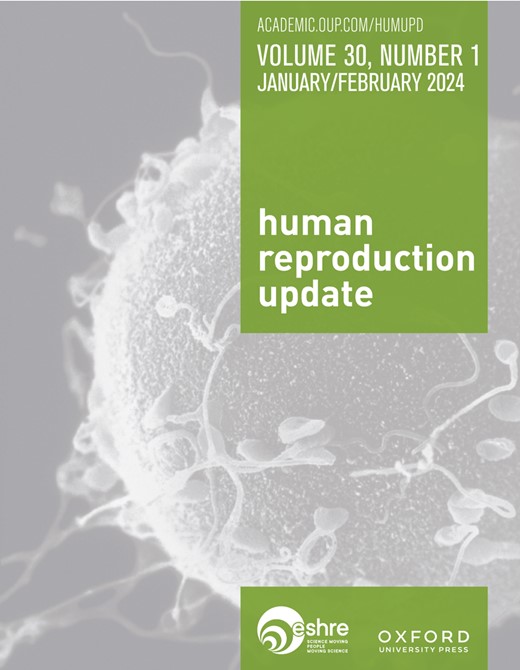Building a human pluripotent stem cell-based gonadal niche: improving in vitro systems with in vivo insights
IF 16.1
1区 医学
Q1 OBSTETRICS & GYNECOLOGY
引用次数: 0
Abstract
BACKGROUND The gonadal somatic niche is crucial for sex determination and gamete formation throughout the human life cycle. However, key steps in gonadal somatic lineage differentiation occur during embryonic and foetal development, making them difficult to study in humans. In vitro differentiation models are therefore needed to investigate gonadal development, support in vitro gametogenesis, and study infertility. A comprehensive overview of gonadal somatic niche differentiation, both in vivo and in vitro, is thus crucial. OBJECTIVE AND RATIONALE This review connects in vivo knowledge with in vitro differentiation systems for gonadal somatic niches, predominantly focusing on cell–cell signalling factors. It evaluates existing in vitro protocols for differentiating testicular and ovarian somatic niches, discusses them in the context of in vivo findings, and explores potential advancements in model systems. SEARCH METHODS A narrative review was conducted after a comprehensive search of the PubMed database through to February 2025; the review focused on search topics including: in vivo gonadal differentiation in humans and mice; in vitro differentiation of human embryonic stem cells or human-induced pluripotent stem cells into gonadal somatic cells (bipotential, Sertoli or granulosa cells); and evidence for the cell–cell signalling factors used in these protocols. OUTCOMES We investigated various strategies that aim to differentiate human pluripotent stem cells into gonadal somatic cell lineages. These include sequential growth factor differentiation recapitulating all known developmental progenitor stages, directed growth factor differentiation that omitted one or more developmental intermediates, and directed overexpression of key transcription factors. To induce differentiation, the growth factor-based protocols used various cell–cell signalling factors, with some derived from in vivo studies, while others lacked direct in vivo evidence. Despite significant advances in guiding pluripotent stem cells towards gonadal differentiation, challenges remain, such as the limited molecular and functional validation of the generated cell types. Consequently, complete human in vitro gametogenesis through co-culture techniques with pluripotent cell-derived germ cells has not yet been achieved, indicating that full functional maturation of the gonadal niche has not been attained with the current protocols. WIDER IMPLICATIONS Integrating knowledge on in vivo gonadal development with enhanced differentiation protocols offers the potential to reliably generate the gonadal somatic niche in vitro. This allows for more accurate modelling of the gonad, facilitating deeper insights into the normal and pathological processes involved in gonadal development and germ cell maturation. For example, it could help to identify mechanisms linked to infertility or differences of sex development. Importantly, as many of these models are based on human pluripotent stem cells, they have the potential for personalization, enabling future patient-specific models for studying reproductive disorders and developing tailored fertility treatments. REGISTRATION NUMBER n/a.建立一个人类多能干细胞为基础的性腺生态位:改善体外系统与体内的见解
性腺体细胞生态位在整个人类生命周期中对性别决定和配子形成至关重要。然而,性腺体细胞谱系分化的关键步骤发生在胚胎和胎儿发育过程中,这使得它们难以在人类中进行研究。因此,需要体外分化模型来研究性腺发育,支持体外配子体发生和研究不孕症。因此,对体内和体外性腺体细胞生态位分化的全面概述是至关重要的。目的和原理本综述将体内知识与性腺体细胞生态位的体外分化系统联系起来,主要关注细胞-细胞信号因子。它评估了现有的用于区分睾丸和卵巢体细胞生态位的体外方案,在体内研究结果的背景下讨论了它们,并探索了模型系统的潜在进展。检索方法对PubMed数据库进行全面检索,检索时间截止到2025年2月;综述的检索主题包括:人与小鼠体内性腺分化;人胚胎干细胞或人诱导多能干细胞在体外分化为性腺体细胞(双潜能细胞、支持细胞或颗粒细胞);以及这些协议中使用的细胞-细胞信号因子的证据。结果:我们研究了旨在将人类多能干细胞分化为性腺体细胞谱系的各种策略。这些包括序贯生长因子分化概括了所有已知的发育祖细胞阶段,定向生长因子分化省略了一个或多个发育中间体,以及定向过度表达关键转录因子。为了诱导分化,基于生长因子的方案使用了各种细胞-细胞信号因子,其中一些来自体内研究,而另一些则缺乏直接的体内证据。尽管在引导多能干细胞向性腺分化方面取得了重大进展,但仍然存在挑战,例如所生成的细胞类型的分子和功能验证有限。因此,通过与多能细胞来源的生殖细胞共培养技术完成的人类体外配子发生尚未实现,这表明目前的方案尚未实现性腺生态位的完全功能成熟。将体内性腺发育的知识与增强的分化方案相结合,提供了在体外可靠地产生性腺体细胞生态位的潜力。这允许更准确地模拟性腺,促进更深入地了解性腺发育和生殖细胞成熟的正常和病理过程。例如,它可以帮助确定与不孕或性发育差异有关的机制。重要的是,由于许多这些模型都是基于人类多能干细胞,因此它们具有个性化的潜力,使未来的患者特异性模型能够用于研究生殖疾病和开发量身定制的生育治疗。注册号码n/a。
本文章由计算机程序翻译,如有差异,请以英文原文为准。
求助全文
约1分钟内获得全文
求助全文
来源期刊

Human Reproduction Update
医学-妇产科学
CiteScore
28.80
自引率
1.50%
发文量
38
期刊介绍:
Human Reproduction Update is the leading journal in its field, boasting a Journal Impact FactorTM of 13.3 and ranked first in Obstetrics & Gynecology and Reproductive Biology (Source: Journal Citation ReportsTM from Clarivate, 2023). It specializes in publishing comprehensive and systematic review articles covering various aspects of human reproductive physiology and medicine.
The journal prioritizes basic, transitional, and clinical topics related to reproduction, encompassing areas such as andrology, embryology, infertility, gynaecology, pregnancy, reproductive endocrinology, reproductive epidemiology, reproductive genetics, reproductive immunology, and reproductive oncology. Human Reproduction Update is published on behalf of the European Society of Human Reproduction and Embryology (ESHRE), maintaining the highest scientific and editorial standards.
 求助内容:
求助内容: 应助结果提醒方式:
应助结果提醒方式:


